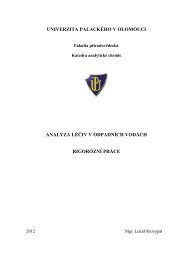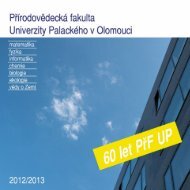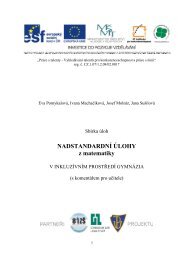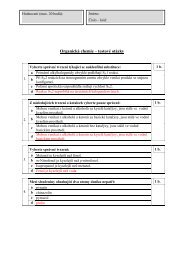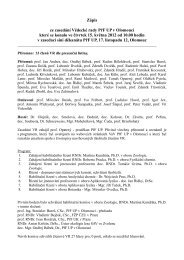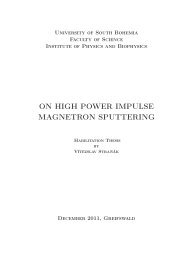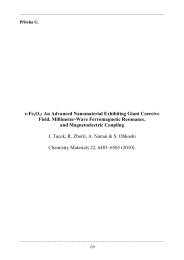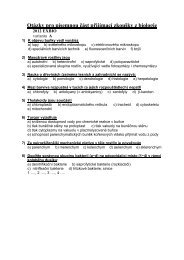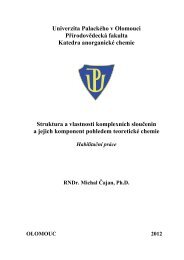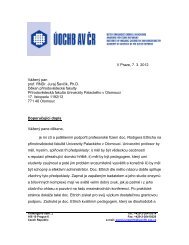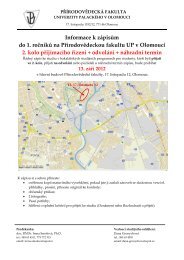A comparative structural analysis of direct and indirect shoot ...
A comparative structural analysis of direct and indirect shoot ...
A comparative structural analysis of direct and indirect shoot ...
You also want an ePaper? Increase the reach of your titles
YUMPU automatically turns print PDFs into web optimized ePapers that Google loves.
60 M. Volgger et al.<br />
other c<strong>and</strong>idates (as mentioned above) will have to be<br />
re-considered.<br />
The Hechtian reticulum may play a role in deplasmolysis<br />
In fact, not only punctuate Hechtian str<strong>and</strong> adhesion sites<br />
remain attached to the inner surface <strong>of</strong> the cell wall in<br />
plasmolysed plant cells. A network that reminds <strong>of</strong> cortical<br />
ER, the Hechtian reticulum, was observed in plasmolysed<br />
onion inner epidermal cells after staining with DiOC 6 (Oparka<br />
et al. 1990; Oparka 1994; Lang-Pauluzzi <strong>and</strong> Gunning 2000).<br />
It is similar to reticulum that lined the inner walls <strong>of</strong> the root<br />
hairs after staining for plasma membrane <strong>and</strong> ER. It was<br />
suggested that the same membrane-spanning linkages which<br />
attach the plasma membrane to the wall on its external face<br />
might also anchor the ER to its internal face (Oparka 1994).<br />
Elements <strong>of</strong> the actin cytoskeleton could be such c<strong>and</strong>idates;<br />
they are closely associated with the plasma membrane <strong>and</strong><br />
the cortical ER (Lichtscheidl <strong>and</strong> Url 1990; Lichtscheidl <strong>and</strong><br />
Hepler 1996; Overall et al. 2001; Baluška et al. 2003),<br />
possibly providing a scaffold for the re-affixture or realignment<br />
<strong>of</strong> the protoplast during deplasmolysis. In the root hairs<br />
that we investigated here, deplasmolysis usually led to<br />
disruption <strong>of</strong> the cells. Obviously, the newly synthesised<br />
wall at the tip is too weak <strong>and</strong> misses a “rescue pattern” to<br />
withst<strong>and</strong> that pressure.<br />
Roots adapt to hypertonic conditions<br />
Exposure <strong>of</strong> roots to hypertonic media stopped root hair<br />
growth immediately. However, during prolonged treatment,<br />
roots themselves continued to grow, <strong>and</strong> they even developed<br />
new root hairs in mannitol solutions as high as 450 mOsm. The<br />
adapted roots were shorter, <strong>and</strong> also the newly formed root<br />
hairs were shorter, although the velocity <strong>of</strong> their growth <strong>and</strong><br />
their polar organisation were identical to the control (Fig. 6).<br />
Their osmotic value was significantly higher; 250 mOsm<br />
corresponds to the onset <strong>of</strong> proper plasmolysis <strong>and</strong> detachment<br />
<strong>of</strong> the protoplast from the cell wall in T. aestivum.<br />
Accordingly, it needed much higher osmotic values to induce<br />
plasmolysis. Obviously, osmotically active substances were<br />
mobilised that help to adjust to the surrounding medium.<br />
From the curve in Fig. 7a, we conclude that such elevation <strong>of</strong><br />
the osmotic value <strong>of</strong> the wheat root hair is triggered by a<br />
plasmolysing concentration <strong>of</strong> 300 mOsm <strong>and</strong> above.<br />
A putative role <strong>of</strong> aquaporins during plasmolysis<br />
Aquaporins may play a key role during osmotic stress<br />
situations, <strong>and</strong> both types <strong>of</strong> aquaporins, plasma membrane<br />
intrinsic proteins <strong>and</strong> tonoplast intrinsic proteins (TIPs),<br />
have been shown to occur in plants (for review, see<br />
Johansson et al. 2000 <strong>and</strong>/or Tyerman et al. 2002).<br />
Recently, osmotic water permeability <strong>of</strong> plasma <strong>and</strong><br />
vacuolar membranes was elegantly measured in radish<br />
(Raphanus sativus) protoplasts <strong>and</strong> high aquaporin activity<br />
observed in both the plasma membrane <strong>and</strong> the tonoplast<br />
(Murai-Hatano <strong>and</strong> Kuwagata 2007). At present, all<br />
examined plant aquaporins have enhanced the osmotic<br />
water permeability, although aquaporin function, dependent<br />
on osmotic gradients, is a passive element. Thus, the rate <strong>of</strong><br />
aquaporin-mediated water transport also depends on other<br />
active transporters <strong>and</strong> ion channels. However, vacuolar<br />
membranes containing abundant TIPs are effective to<br />
prevent plasmolysis (Hara-Nishimura <strong>and</strong> Maeshima 2000).<br />
At the protein level, aquaporins are not the only group <strong>of</strong><br />
targeted c<strong>and</strong>idates. Several protein kinases are also known<br />
to be involved in both salt <strong>and</strong> osmotic stress as well as in<br />
wounding <strong>and</strong> drought, e.g. SIMK <strong>and</strong> SAMK (Jonak et al.<br />
1996; Meskiene <strong>and</strong> Hirt 2000; Šamaj et al. 2002; Ovečka<br />
et al. 2008b). Furthermore, plant responses to abiotic<br />
stresses like drought stress, osmotic stress or wounding<br />
are closely related to signalling roles <strong>of</strong> plant hormones<br />
ABA <strong>and</strong> jasmonic acid (Denekamp <strong>and</strong> Smeekens 2003).<br />
Using mutant <strong>analysis</strong>, many Arabidopsis genes have been<br />
identified that affect the process <strong>of</strong> tip growth (Parker et al.<br />
2000). One <strong>of</strong> them is the Arabidopsis sos4 mutant, salt<br />
overly sensitive 4, that was isolated by screening for NaClhypersensitive<br />
growth. The SOS4 gene encodes a pyridoxal<br />
kinase involved in the production <strong>of</strong> pyridoxal-5-phosphate.<br />
The general phenotype <strong>of</strong> sos4 is salt hypersensitivity, but<br />
additionally, sos4 roots failed to form root hairs, <strong>and</strong><br />
rhizodermis showed only a few bulges (Shi <strong>and</strong> Zhu<br />
2002). Further <strong>analysis</strong> <strong>of</strong> the salt overly sensitive mutants<br />
showed a dose-dependent reduction <strong>of</strong> root hair density by<br />
salt treatments (Wang et al. 2008b). The authors found that<br />
Na + ,K + <strong>and</strong> Li + , but neither the closely related Cs + nor<br />
mannitol stress, caused inhibition <strong>of</strong> root hair development.<br />
By contrast, osmotic stress caused by 200 mM mannitol<br />
increased root hair density <strong>and</strong> promoted root hair growth<br />
rate in stressed Arabidopsis roots. This suggests that the<br />
inhibitory effects <strong>of</strong> salt on root hair development were<br />
caused by ion disequilibrium <strong>and</strong> not by osmotic effects. In<br />
the present study, we therefore deliberately focussed on<br />
plasmolytic solutions that do not exhibit ion stress on top <strong>of</strong><br />
osmotic stress.<br />
Conclusions<br />
Cell wall deposition in tip-growing root hairs is independent<br />
<strong>of</strong> turgor pressure because it occurs under every<br />
osmotic condition tested. Roots can adapt to osmotic<br />
conditions to a certain extent <strong>and</strong> can form root hairs also<br />
in hypertonic media by elevation <strong>of</strong> the osmotic value <strong>of</strong><br />
the cells. In future experiments, we hope to gain more




